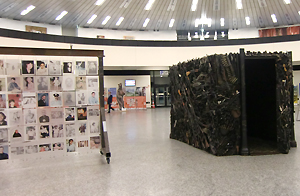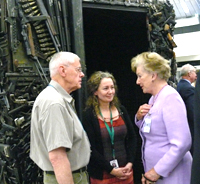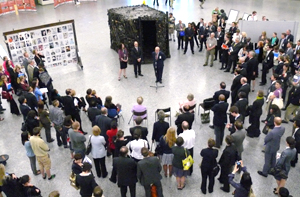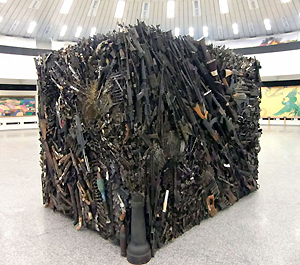 Following the unveiling last week of an imposing five-ton art installation made up of some 7,000 deactivated weapons in the middle of the Rotunda of the Vienna International Centre, UN staff, diplomats and visitors from all walks of life continue to be drawn to its gripping "appeal". The massive Gun Sculpture was developed by Canadian artists Sandra Bromley and Wallis Kendal as their comment on the culture of violence engulfing many modern societies and is made entirely of decommissioned weapons such as handguns, ammunition and landmines . The Gun Sculpture is part of an exhibition called The Art of Peacemaking which in addition to the Sculpture itself, includes a mural showing photographs of victims of war, crime, and other forms of violence around the world, a board on which visitors can leave their own comments on the exhibition and a screening of a documentary on the making of the Gun Sculpture. The launch of the exhibition at the United Nations Headquarters in Vienna coincided with the annual meeting of the Academic Council on the United Nations System (ACUNS) from 3-5 June, which was held under the theme of New Security Challenges.
Following the unveiling last week of an imposing five-ton art installation made up of some 7,000 deactivated weapons in the middle of the Rotunda of the Vienna International Centre, UN staff, diplomats and visitors from all walks of life continue to be drawn to its gripping "appeal". The massive Gun Sculpture was developed by Canadian artists Sandra Bromley and Wallis Kendal as their comment on the culture of violence engulfing many modern societies and is made entirely of decommissioned weapons such as handguns, ammunition and landmines . The Gun Sculpture is part of an exhibition called The Art of Peacemaking which in addition to the Sculpture itself, includes a mural showing photographs of victims of war, crime, and other forms of violence around the world, a board on which visitors can leave their own comments on the exhibition and a screening of a documentary on the making of the Gun Sculpture. The launch of the exhibition at the United Nations Headquarters in Vienna coincided with the annual meeting of the Academic Council on the United Nations System (ACUNS) from 3-5 June, which was held under the theme of New Security Challenges.
 Artists Bromley and Kendal said that the sculpture is meant to challenge visitors intellectually and emotionally and to provoke thoughts and a discussion on the culture of violence. They added that the weapons in the sculpture were used as a metaphor for the 20th-century violence, which many argue was the most violent century in human history. After five years of collecting weapons, small arms, portraits and brief stories of victims of violence from around the world, the artists completed the Art of Peacemaking exhibition in 2000. The weapons in the sculpture were donated by police departments from crime seizures/forensic laboratories or were sent from military warehouses from around the world. They include a variety of anti-tank and anti-personnel landmines, mortar shells, 110 mm recoilless rifles, AK47s, sawed-off shotguns of different makes, knives and other non-fire arm weapons.
Artists Bromley and Kendal said that the sculpture is meant to challenge visitors intellectually and emotionally and to provoke thoughts and a discussion on the culture of violence. They added that the weapons in the sculpture were used as a metaphor for the 20th-century violence, which many argue was the most violent century in human history. After five years of collecting weapons, small arms, portraits and brief stories of victims of violence from around the world, the artists completed the Art of Peacemaking exhibition in 2000. The weapons in the sculpture were donated by police departments from crime seizures/forensic laboratories or were sent from military warehouses from around the world. They include a variety of anti-tank and anti-personnel landmines, mortar shells, 110 mm recoilless rifles, AK47s, sawed-off shotguns of different makes, knives and other non-fire arm weapons.
The timing of the Sculpture's second showing in a UN venue also coincides with the fourth biennial meeting of States to review implementation of the Programme of Action on Illicit Trade in Small Arms and Light Weapons which will take place from 14 to 18 June 2010 in New York. Since its first appearance at the UN HQ in NY in 2001 during the United Nations Conference on Illicit Trade in Small Arms and Light Weapons in All Its Aspects, the Sculpture has been exhibited on three continents and was viewed by one and a half million people.
Sandra Bromley said that as the active participation of the viewer is an essential part of the sculpture installation, over 150,000 visitor contributions (comments, drawings, poems, etc) have been collected to date.

Speaking at the unveiling ceremony on 4 June 2010, Director of the United Nations Information Service (UNIS) Vienna, Maher Nasser said that he was most impressed with the amount of interest the exhibition had created and by the mostly positive feedback received or communicated on the accompanying board. "Art is not only about beauty, but also about evoking emotional responses that triggers a thought process. Today's exhibition exposes the tools of violence and their ugly impact on human life" added Maher Nasser.
According to the United Nations Office on Drugs and Crime (UNODC), the market for illicit arms is estimated globally at US$ 200-300 million per year, which is about 20 per cent of the (licit and measurable) arms trade and every year, small arms account for around 300,000 deaths. Africa, the arms smugglers' most profitable market, suffers the largest number of casualties because of it.
Among the comments left by viewers on the board next to the Gun Sculpture was one by former IAEA Director General Hans Blix in which he said "Small calibre weapons are Weapons of Mass Destruction"; "Thank you very much ! Your sculpture gives me a really bad feeling, and I think that's how it should be" - anonymous; "13 people died in Cumbria UK. Gun crimes can be random and often affect innocents" - anonymous; and an 8-year-old wrote "Peace is better than violence! So if you don't cause violence, we could all live in harmony" - Razan.
To date only 79 Members States are parties to the Protocol against the Illicit Manufacturing of and Trafficking in Firearms, Their Parts and Ammunition, supplementing the United Nations Convention against Organized Crime, which entered into force in July 2005. Parties to the Protocol are required to adopt legislation to prevent guns from falling into the wrong hands; criminalize the removal of the markings on guns; keep the records necessary to trace them; prevent the re-activation of disabled guns; promote cooperative regimes to monitor gun flows; prevent weapons theft; and build law enforcement capacity across borders.
The Gun Sculpture will be on display in the Rotunda of the VIC until the end of the July and can be seen as part of the guided tours of the United Nations in Vienna.
